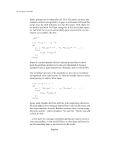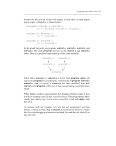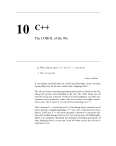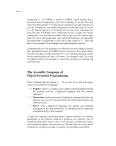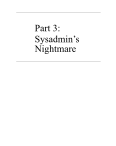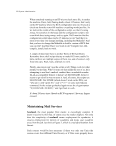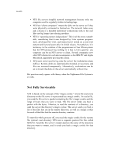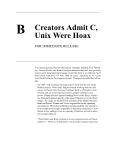160 csh, pipes, and find fact, even if it prints an error message to the screen, it still reports “good news,” i.e., status 0. Try this in a shell script: tar cf temp.tar no.such.file if( $status == 0 ) echo "Good news! No error." and you get this: tar: no.such.file: No such file or directory Good news! No error. I know—I shouldn’t have expected anything consistent, useful, doc- umented, speedy, or even functional… Bjorn Pipes My judgment of Unix is my own. About six years ago (when I first got my workstation), I spent lots of time learning Unix. I got to be fairly good. Fortunately, most of that garbage has now faded from mem- ory. However, since joining this discussion, a lot of Unix supporters have sent me examples of stuff to “prove” how powerful Unix is. These examples have certainly been enough to refresh my memory: they all do something trivial or useless, and they all do so in a very arcane manner. One person who posted to the net said he had an “epiphany” from a shell script (which used four commands and a script that looked like line noise) which renamed all his '.pas' files so that they ended with “.p” instead. I reserve my religious ecstasy for something more than renaming files. And, indeed, that is my memory of Unix tools—you spend all your time learning to do complex and peculiar things that are, in the end, not really all that impressive. I decided I’d rather learn to get some real work done. —Jim Giles Los Alamos National Laboratory Unix lovers believe in the purity, virtue, and beauty of pipes. They extol pipes as the mechanism that, more than any other feature, makes Unix Unix. “Pipes,” Unix lovers intone over and over again, “allow complex
Pipes 161 programs to be built out of simpler programs. Pipes allow programs to be used in unplanned and unanticipated ways. Pipes allow simple implementations.” Unfortunately, chanting mantras doesn’t do Unix any more good than it does the Hari Krishnas. Pipes do have some virtue. The construction of complex systems requires modularity and abstraction. This truth is a catechism of computer science. The better tools one has for composing larger systems from smaller sys- tems, the more likely a successful and maintainable outcome. Pipes are a structuring tool, and, as such, have value. Here is a sample pipeline:3 egrep '^To:|^Cc:' /var/spool/mail/$USER | \ cut -c5- | \ awk '{ for (i = 1 i = NF i++) print $i }' | \ sed 's/,//g' | grep -v $USER | sort | uniq Clear, huh? This pipeline looks through the user’s mailbox and determines which mailing lists they are on, (well, almost). Like most pipelines, this one will fail in mysterious ways under certain circumstances. Indeed, while pipes are useful at times, their system of communication between programs—text traveling through standard input and standard out- put—limits their usefulness.4 First, the information flow is only one way. Processes can’t use shell pipelines to communicate bidirectionally. Second, pipes don’t allow any form of abstraction. The receiving and sending pro- cesses must use a stream of bytes. Any object more complex than a byte cannot be sent until the object is first transmuted into a string of bytes that the receiving end knows how to reassemble. This means that you can’t send an object and the code for the class definition necessary to implement the object. You can’t send pointers into another process’s address space. You can’t send file handles or tcp connections or permissions to access particular files or resources. At the risk of sounding like a hopeless dream keeper of the intergalactic space, we submit that the correct model is procedure call (either local or remote) in a language that allows first-class structures (which C gained during its adolescence) and functional composition. 3Thanks to Michael Grant at Sun Microsystems for this example. 4We should note that this discussion of “pipes” is restricted to traditional Unix pipes, the kind that you can create with shell using the vertical bar (|). We’re not talking about named pipes, which are a different beast entirely.



































































































































































































